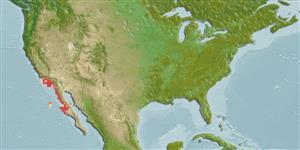>
Ovalentaria/misc (Various families in series Ovalentaria) >
Pomacentridae (Damselfishes) > Microspathodontinae
Etymology: Hypsypops: Greek, hypsy, hypops = high + Greek, ops = appearance (Ref. 45335).
More on author: Girard.
Environment: milieu / climate zone / depth range / distribution range
Ecologie
marien rifbewoner; standvastig; diepte 0 - 30 m (Ref. 9334). Subtropical; 37°N - 27°N, 122°W - 114°W
Eastern Central Pacific: Monterey Bay in California, USA to southern Baja California and Guadalupe Island (off northern central Baja California) in Mexico.
Grootte / Gewicht / Leeftijd
Maturity: Lm ? range ? - ? cm
Max length : 30.0 cm SL mannelijk / geslacht onbekend; (Ref. 7247); max. gerapporteerde leeftijd: 57 Jaren (Ref. 52465)
Dorsale stekels (totaal): 12; Dorsale zachte stralen (totaal): 16-17; Anale stekels 2; Anale zachte stralen: 13 - 14
Adults occur over rocky bottom in clear water, often near crevices and small caves, occasionally in kelp. Adults defend a home territory. Feed mainly on attached invertebrates. Oviparous, distinct pairing during breeding (Ref. 205). Eggs are demersal and adhere to the substrate (Ref. 205). Males guard and aerate the eggs (Ref. 205). Have been reared in captivity (Ref. 35420).
Oviparous, distinct pairing during breeding (Ref. 205). Male clears a sheltered nest site; female deposits eggs, which male guards (Ref. 2850).
Allen, G.R., 1991. Damselfishes of the world. Mergus Publishers, Melle, Germany. 271 p. (Ref. 7247)
Status op de Rode Lijst van het IUCN (Ref. 130435)
Gevaar voor de mens
Harmless
Gebruik door de mens
Meer informatie
ReferentiesAquacultuurAquacultuurprofielKweeklijnenGeneticaElectrophoresesErfelijkheidZiektesVerwerkingNutrientsMassaconversie
Tools
Speciale rapporten
Download XML
Internetbronnen
Estimates based on models
Preferred temperature (Ref.
123201): 15.3 - 19.2, mean 17.5 °C (based on 48 cells).
Fylogenetische diversiteitsindex (Ref.
82804): PD
50 = 1.0000 [Uniqueness, from 0.5 = low to 2.0 = high].
Bayesian length-weight: a=0.01950 (0.00922 - 0.04124), b=3.00 (2.82 - 3.18), in cm total length, based on LWR estimates for this (Sub)family-body shape (Ref.
93245).
Trofisch niveau (Ref.
69278): 3.2 ±0.39 se; based on food items.
Generation time: 6.5 (5.8 - 7.3) years. Estimated as median ln(3)/K based on 28
growth studies.
Weerstandsvermogen (Ref.
120179): laag, minimale populatieverdubbelingstijd 4,5-14 jaar (tmax=20; tm=5).
Fishing Vulnerability (Ref.
59153): Moderate to high vulnerability (51 of 100).
Nutrients (Ref.
124155): Calcium = 31.5 [13.7, 58.8] mg/100g; Iron = 0.521 [0.293, 0.911] mg/100g; Protein = 19.1 [17.9, 20.3] %; Omega3 = 0.148 [0.084, 0.258] g/100g; Selenium = 12.9 [6.1, 28.0] μg/100g; VitaminA = 48.5 [12.4, 190.6] μg/100g; Zinc = 0.866 [0.555, 1.315] mg/100g (wet weight);
